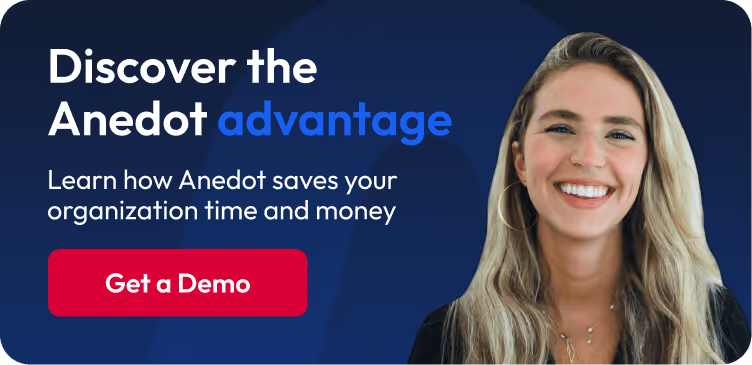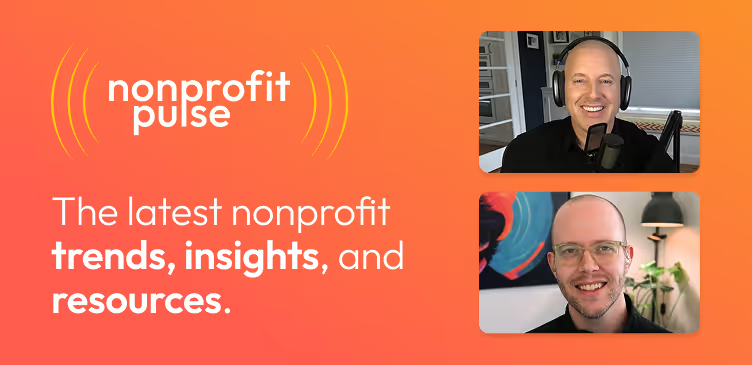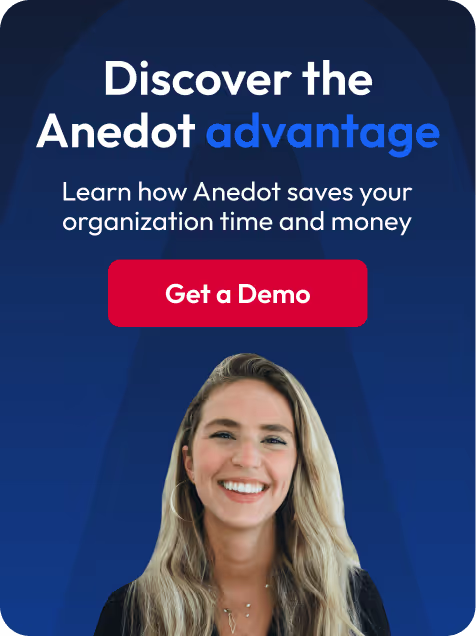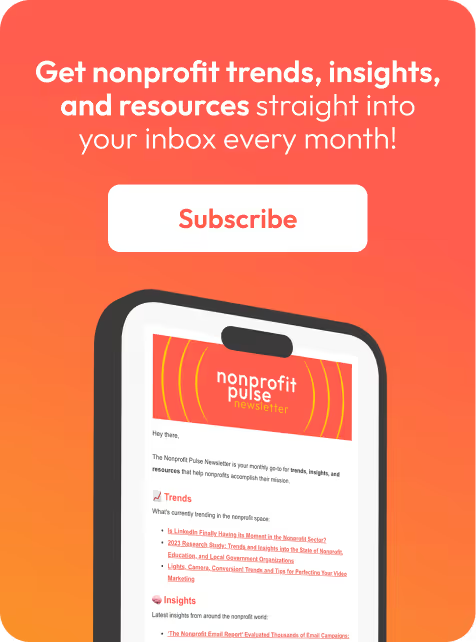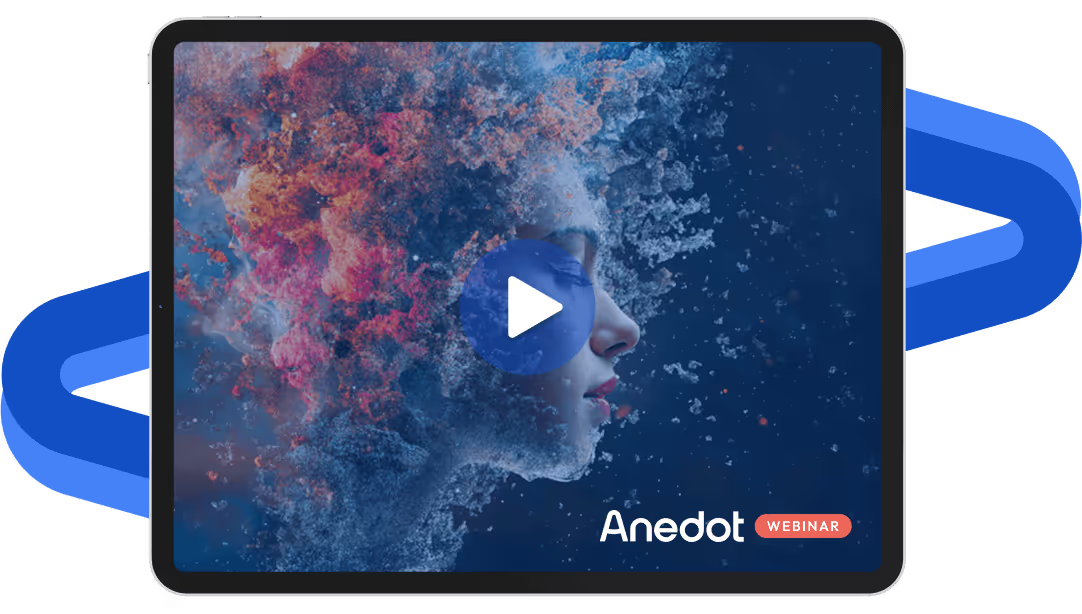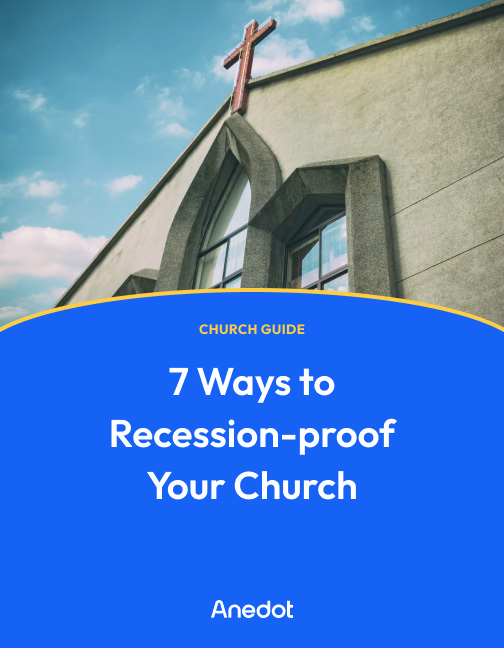Anedot Learn session transcript ↓
Colleen:
Hey, this is Colleen from Anedot.
Welcome to Anedot Learn where we help you grow your organization through giving.
Today we're joined by Patrick from our team. We often get asked questions whether it's better to use a hosted form or better to use an iframe when sharing your donation page.
So I've put together a few questions that really outline this topic and explain why it's better to use a hosted form over an iframe.
So Patrick, thank you for joining and just hopping on and answering all of these questions.
How does using a custom domain on a hosted form enhance the branding and identity of a website compared to using iframes?

Colleen:
I wanted to kick it off with branding and identity.
So the first question that I have for you is how does using a custom domain on a hosted form enhance the branding and the overall identity of a website compared to using an iframe?
Patrick:
Yeah, for sure. I mean, I think maybe to get started, I'll talk a little bit about hosted form versus iframe in case anyone's unfamiliar.
So a hosted form is a form that is the Anedot page. It's the Anedot page that we provide.
You know, there's other donation platforms and other landing page software that offer something similar.
But the idea is you are not embedding this into your website. This is just a page completely separate from your website. That's what a hosted form is.
An iframe is a piece of code that you embed into your website.
There's kind of, as you said, there's a lot of different opinions on this topic. I think one thing is, as you mentioned, that we get a lot of questions on is nonprofit branding and identity.
So, you know, the thing people say about iframes as well, it's got my branding, it's got my logo. And you can accomplish both with iframes or hosted pages.
So for branding and identity, within Anedot and most landing page software, they allow you to put in your logo, change the colors, change the amounts, change the look of the page, add a background image.
We can enable custom CSS on any page and make any customizations and changes.
So from a branding and identity standpoint, there's a lot of similarities between the two, and you can accomplish a lot of the same things with either or.
So what I would say is, I wouldn't necessarily consider branding or identity to be a factor in your decision on whether to use one or the other, because it's going to give you a very similar experience from that perspective.
How do hosted forms impact conversion rates?

Colleen:
Correct. Right. And kind of on that same topic, what about taking a step back and looking at how do hosted forms impact your conversion rates overall?
Patrick:
Yeah. So this is a really interesting one that we've identified that hosted forms improve your conversion rate.
We have done testing. We've had digital marketing agencies do testing, but hosted forms convert better.
There's a number of different factors and reasons why.
Some of them we'll talk about like load times and things like that. Some of them are just the fact that it's a more reliable process, right?
The loading times are better and the design is clean. Right?
So with an iframe, a lot of times you're going to try to put in more content.
You're going to have the navigation bar and you’re gonna have all of these things on your page and all these extra things that you add, the data shows it actually reduce conversions most of the time that if you have too much information and too many things on a page or too much mental load, it will lead to fewer donations.
So a really interesting one that's not tied to sort of iframes and hosted forms is we've actually done a test where we have all the information you're collecting all in line versus having it stepped, where somebody would type in, choose their amount, then type in their name, then do their payment information.
The testing that we've had done shows that just them having to click and having to go through and have more stuff in front of them can reduce conversions 25 to 50%.
Like massive, massive amounts.
And that's a ton of lost revenue for an organization.
So it's really important to have something really optimized. And our hosted forms are extremely optimized for conversion.
Like we've got a ton of testing and it's set up from a stock standpoint where if you add your logo, you add a little text, that is going to be the most optimal set up to get as many donations as you can.
What security considerations differentiate hosted forms from iframes, and how does this impact supporter trust and data protection?

Colleen:
Absolutely. Yeah, it's huge to look at it from the conversion perspective and as you mentioned, hosted forms do really well with that.
And moving on to kind of the topic of security, what security considerations differentiate between hosted forms and iframes and how does it impact supporter’s trust and data protection?
Patrick:
Yeah, I mean, Apple and Google, you know, they are generally the two leaders when it comes to browser technology.
You know, Apple obviously, Safari. And Google not only has Chrome, which you think of, but a lot of Chromium based products, which, you know, other Chromium based products include Microsoft Edge, which comes stock in Windows. It includes Brave, which a lot of us use.
It includes all kinds of different, you know, offshoots of Chrome. And they have both stated that they are they're not huge fans of iframes. Right.
They think of iframes as security vectors. We see iframes as potential security vectors.
Google Pay and Apple Pay do not work great with iframes.
They're problematic. There's a lot of things that you can't do with iframes.
So some of our enhanced technology, like our Workflows and some of the different kinds of, you know, improved technologies that we're offering out there that will help conversion rates and allow you to do more things, that just simply can't work with an iframe because you can't just kind of pigeonhole all of that into this tiny little box that is typically an iframe.
So it's an issue. It creates a security vector, it makes it harder for conversions.
They tend to have load time issues because not only are you waiting for your web page to load, you're also waiting for that little box to load rather than just having us load it where, you know, we're handling literally millions of dollars of donations a day from our customers.
So we are used to a lot of web traffic, you know, way more web traffic than probably nearly every customer that we have. So we're equipped to handle that.
So using our pages, you're not going to have these glitches and things like that.
Whereas with an iframe, there's a very good chance you're going to because you're dealing with two different aspects now that you have to work with.
So those are the different things to kind of think about.
And from a security standpoint, some things to watch out for. You know, another thing, too, is if you are doing Facebook ads or any kind of advertising, you know, generally iframes are a lot more unreliable for those kind of things.
And those advertisers often want to see a more reliable, consistent experience and something that's on the domain itself.
So those are all factors that have to be thought about.
In terms of user experience, what advantages do hosted forms offer over iframes when it comes to seamless navigation and interactions?

Colleen:
Definitely. Yeah.
I can even think of, you know, from a supporter perspective when they're looking at that URL, whether it's using a custom domain or it's just the hosted form that will say secure.anedot.com and have their organization name.
And it also shows the supporter, the donor that it's secure and makes them feel comfortable and at ease as well.
So that's important as well.
And kind of on that same topic in terms of user experience, what advantages do hosted forms offer over iframes when it comes to a very seamless, clean navigation?
Patrick:
Yeah, I mean, one really interesting thing about donation pages and landing pages, and when I say landing pages, I mean our lead pages.
So if you're talking about a petition page, a survey page, an email sign up, just collecting information rather than a donation.
What's really interesting is, you know, our friends at NextAfter, they're a fundraising optimization company, you know, we work with a number of other great ones.
You know, we've got Optimize Consulting and we've got a lot of great ones on this Anedot Learn segments.
You know, NextAfter has an excellent experiment section on their website where they actually do A/B testing and they look at these things.
And they've done two studies that I'll reference right here that they did last year with two different customers that were both on radically redesigning a landing page to clarify copy and remove navigation effects.
And both studies showed performance increases, pretty significant performance increases.
So the one was with an organization called Luther Seminary, and that showed improvements.
You know, just the same copy, removing the navigation bar showed a 10% improvement in conversion at over 70% confidence.
So you do nothing else. You remove your navigation bar and you're going to see 10 to 20% just off the top.
The second study was with an organization called The Navigators, and they did something similar.
They changed the text and changed the button locations and things like that.
And what's interesting is they actually when they did the radical redesign, the way they changed it is they actually changed it to what looks like our default setting, what we typically do, where the content is above the buttons or below.
There's no navigation bar. And they saw a 200% increase in that one.
So one of the biggest reasons we see customers say, I want to use an iframe, is well, I want a navigation bar and I want my footer and I want to include all these other ways to give.
And there's two studies that were done in the last year that make it clear that you are potentially losing 20 to 20 plus percent of your donations by doing that.
By changing that, you could be improving your donations significantly by not having those things.
And we had a study, too, from a customer as well that previously had an iframe page and a lot of content on the page, and they’re like, oh, this was, when we tested it worked the best and we talked to them for a while and said, hey, why don't you try our simpler hosted page?
And it took a little while. And once they did, they said, wow, we see a 20% increase in conversions and this was their big membership page that they do all their membership programs.
And that just kind of validated the NextAfter study is that we now had one on Anedot too that says, look, you are literally giving up donations by trying to do the navigation bar and have all of this information.
Like if it is really important for you to include how to give stock and how to give these other ways, there's other links and things that you can put in content blocks, like you can go to our two column page and you can include that information as links.
But if you include way too much information and you make the page, include all of the other ways to give and make the little donate page really small because you want to iframe it that’s going to hurt you.
That is going to reduce your conversions.
So I think it's really important when you are looking at donation and landing pages that you let - a lot of times, most of the time less is more.
You don't want to push things below the fold. You don't want to have all this extra things that people can click on because that will reduce conversions.
And to me, that's the number one reason that somebody would tell me, well we have to use an iframe because I want it to look exactly like my website and I would say, well, that's a mistake.
That’s not just a preference thing. That is a mistake. And we have the same, you know, the same incentive as our customers do, which is for them to raise more money and be successful.
And the last thing that you want is donors to go to your page and be interested and then them not convert because the page was not optimized properly.
So that's something that I would say very specifically is that you can get that branding on an Anedot hosted page and you don't want the other things that you could do with iframes.
It's not going to help you raise more money.
Colleen:
Yeah. Awesome. Yeah, I love those studies because it really shows the data on that too.
Because sometimes you think you want to add everything to your donation page, but sometimes it's not always the best for conversion rates. So moving along.
Patrick:
And highly I recommend everyone check out the experiments. Right. Because they have experiments in a lot of other things.
But I think the navigation bar and the radical redesign page redesigns are really interesting because sometimes what we think as, oh, this is going to be great, doesn't necessarily pan out.
And sometimes there's some really interesting donor psychology behind it that should be taken into consideration.
What are the advantages of using hosted forms over iframes when it comes to mobile devices?

Colleen:
Yeah, and I wanted to touch on specifically the implications of website performance and loading times, especially when it comes to donations that are made on mobile devices because we know so many people use their iPhone or iPad to make donations.
So could you touch on that? Share a little bit about that as it relates to this topic?
Patrick:
Yeah, I mean, we support iframes for embeds. I mean, there's other types of embeds.
My experience in general is anytime you're embedding, it's usually not great for mobile.
You know, most of our customers were seeing 70 plus percent of donors actually donate on their mobile phone.
And again, if Google and Apple Pay don't function as well, if it doesn't collapse as well into a mobile phone, and if it's an awkward experience, if the scrolling doesn't work as well.
Right. And those are all limitations and issues with iframes. If any one of those don't go as well, you're going to lose donations.
So to me, if most people are using their iPhones and a lot of people have adopted Apple Pay and Google Pay, you know, I've got Apple Pay on my phone, I can just double tap the button, look at my face.
Right. And it processes my donation. If you don't have that, you're giving up money. Like you're really you're giving your donors a poor experience.
They're going to complain and say, I try to give to you, but you made it too hard. And all of those things are things that you don't want to have happen.
So again, it doesn't make sense to introduce that scenario at all with an iframe or any other embed type.
It makes sense just to use a hosted form because we've you know, our pages are designed mobile first, right?
Like our pages are mobile and then expand outward to support background images for desktop. But it's designed for mobile.
I mean, mobile is what we're doing the most of because that is where the majority of donations come at this point.
So I think that's another thing that people don't always think of too, is it's really important to make sure to optimize your donation page, not just optimized for mobile, but it's truly mobile first.
What are the challenges or limitations of using iframes in terms of integration with other web technologies, and how do custom domains address these challenges?

Colleen:
Correct. So necessary.
So what are the challenges or limitations of using iframes in terms of integrations with web technologies?
And how do custom domains address these challenges?
Patrick:
Yeah, so I mentioned Apple and Google are not big fans of iframes.
You know, I know Facebook with iOS 14.5, they introduced, you know, a couple few years ago, they introduced a number of changes for conversion tracking and things that you had to do.
One of the things that they introduced was was domain verification.
And they made it extremely clear that what they want is they want if you're going to be running Facebook conversion campaigns, you want to run all that tracking is that they really want it to be on a custom domain.
They want that custom domain to be verified and run it through the system.
So I think that is really important from a tracking perspective to track those kind of things. It also makes it easier to track what's going on if it's just going through Anedot.
Because again, if you have other things going on in the page, we don't have as much control of what's going on there and what we can do.
So it just it creates more potential points of failure. And that's just never great when it comes to technology like you never want more potential points of failure, right?
We want to reduce that as much as possible. And what I found is a lot of times when pages do have issues, it's because it's using that iframe, because we can't control it.
We can't guarantee performance. If you're taking a piece of that and putting it into your page, we can't guarantee that it's going to work perfectly because it's outside of our sort of walled garden. Right.
And it's kind of like Apple, right? Why do a lot of Apple products work so well? Because Apple is able to optimize the experience to be as perfect as possible.
And that's what we try to do. You know, we try to optimize the experience to maximize the number of donations that our customers are going to receive.
And when you take it out of that experience, it can create potential points of failure.
How do custom domains contribute to a sense of ownership and control over content, and how does this compare to the scenario of using iframes?

Colleen:
Absolutely. Absolutely. And when it comes to ownership and control over content, how do custom domains really cater to that, over using an iframe?
Patrick:
Yeah. I mean, I think you have the same capabilities with both. So I think, you know, if you want to customize it, you can add any kind of content that you want.
You can make it bigger, you can make it smaller, you can change the fonts, you can change the color.
So I think you have full ownership no matter what of what you're doing there, whether it's an iframe or a hosted page.
So if anything, it might make it easier for you because with iframes, most of the time it's a web developer trying to hack things together, put it together. If something changes, they've got to move it around.
Whereas with Anedot pages, we've designed them so a marketer or somebody you know who isn't a coder can go in and they can make those changes, make modifications and do things quickly.
So we have some large customers that, you know, that use really robust CRM systems, but they like using Anedot because they can spin up a bunch of pages and they can they don't have to go to their IT team and say, hey, go get me this.
You know, we have one organization I'm thinking of that they had another platform and they moved over to us because they're like, well, we can't move fast enough.
Like, I can't go to my IT team every single time I need this change made.
So it allowed the marketers to actually guarantee brand consistency because they were the ones building it and doing all of it rather than having to play middle person to a, you know, to a web designer and have to have the IT team have to figure it out.
So that's that's a key distinction that I think is really helpful for development advancement teams.
In terms of future-proofing a web presence, how do hosted forms offer more stability and adaptability compared to relying heavily on iframes?

Colleen:
Absolutely. Very flexible and scalable in that sense, which is awesome.
And in terms of future proofing a web presence, and you touched on this exactly, but how do hosted forms offer a more stable and adaptable presence compared to relying heavily on iframes?
Patrick:
Yeah, it's again, it's less points of failure.
It's the idea that look I don't need to now worry about Anedot loading in an iframe where iframes are notoriously unreliable to begin with and rely on you loading your page.
So let's just say you do have a donation campaign that gets way more donors than usual. You need something that's going to be rock solid to handle all that web traffic.
You know, our pages are used to handling, you know, thousands and thousands and thousands of visits every single day. A lot of technology is not.
The average, like I would say, most of our customers, their websites probably are not used to handling that kind of traffic.
So putting it on their website is not optimal. Instead, what makes a lot more sense is custom domaining it.
You know, we don't charge anything. It's completely free.
So if you want your customer domain to be secure dot your organization dot org slash the page, it's custom branded to you. It's completely free.
All you have to do is clear the CNAME in your DNS settings.
Reach out to our team. We can get it up same business day and inside, when you click View Page, it's going to show the custom domain now whenever you look at the page.
So it just creates that custom branded experience. But you're not taking on any of the burden of actually dealing with any of the IT of it. Right.
So you're not in PCI compliance. You're not dealing with the burden of the ITPs. You're not having to deal with, you know, going direct to Visa and dealing with all the payments.
So it's just taking all of that burden off of your organization so you can just go, oh, I just create this done and Anedot just takes care of the rest for me.
So in some ways, the same way that we've talked about our donor support and how that's really unique, it's very similar on the IT side, we're just using our hosted page takes a level of burden off of an organization so they don't need to deal with that or do those kind of things.
And I think the key here that an organization would need to remember is, look, if there is something you want to do with your page, come talk to our team.
Reach out to us, help@anedot.com. If you feel like you're limited in any way by the hosted page, let's talk through what you're trying to do.
Most of the things you're trying to do that are helpful, we can probably incorporate in the pages and some of them we may want to have a conversation about, is this going to help you raise more money or why is this happening?
Like, why are you trying to do this? And how can we help do this in a way that isn't going to lose you donations?
Because I think the most the hardest thing, you know, probably for you, too, because, I mean, you're on calls of customers every day is it's so frustrating when you're like and I really I know you know, you're trying to do this, but here's the reasons it doesn't work.
And at the end of the day, our incentive is the same as our customers, right?
It's to create the best donor experience possible and ensure that donors aren't going to get frustrated and leave the page and not donate.
Closing thoughts

Colleen:
Yeah, absolutely. Absolutely. I agree with everything you're saying.
And I think this is so helpful because we do get this question so often, like you mentioned.
And just to sum it up overall, hosted forms provide better security performance, better browser performance and experience, better mobile performance and experience, which is huge, better overall performance for conversion rates.
And there's no additional cost for a custom domain.
I think a lot of people might not realize that. So if you have questions, you can always email us at help@anedot.com.
So overall, you know hosted pages over iframes for sure. This was super insightful Patrick.
Thank you for just hopping on and talking through it all. And as always, feel free to email us and help@anedot.com with any questions.
Thank you.
Patrick:
Thanks.
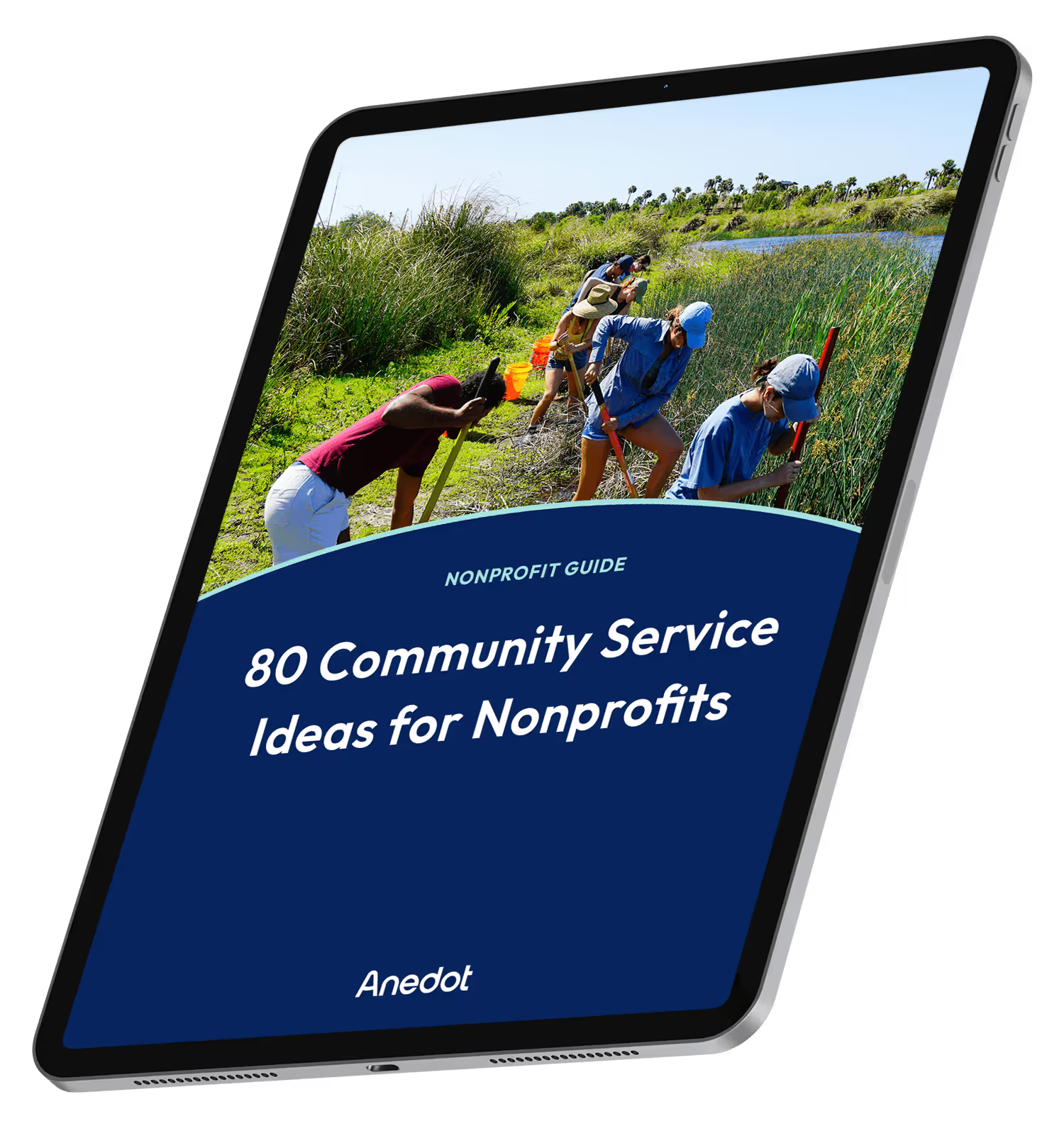
80 Community Service Ideas for Nonprofits
